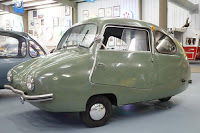$30,000 BIN with offers considered
1956 Goggomobil T 250
$30,000 BIN with offers considered
1957 Heinkel Model 154
$40,000 BIN with offers considered
All cars are in Madison, GA, USA. The auction takes place on February 4 at 12:00 Eastern. Here’s the auction link: https://new.liveauctioneers.com/catalog/99085_microcars-pinballs-and-fine-jewelry
Presumably, any BIN or offer activity will be honored and the lots taken out before Feb 4 (?).
Might this be the coolest microcar style ever?
Yes, it’s a three-wheeler!
And, yes, there’s some plaid here.
Powerhouse!
The Goggomobil is normal and almost boring next to the other two!
The deck lid has a cool, integrated vent for the rear-mounted engine.
No, this is not an Isetta, but it was inspired by it. This was an attempt to make a better one, and it focused on aerodynamics.
Front door and layout are just like the Iso/BMW.
Similar to later Isettas, some of these had four wheels, with the rears tucked in tightly.
We heart plaid!
Fuldamobil ad text:
1954 Fuldamobil Model NWF200. Odometer reads 48440km.
Fuldamobil model S-1 (NWF 200) belongs to microcar / city car class. Represents the “A (mini cars)” market segment. The car was offered with small car three-wheeled body shapes between the years 1954 and 1955.
Cars were equipped with engines of 199 cc (12.2 cui) displacement, delivering 7 kW (9.5 PS, 9 hp) of power. Fuldamobil S-1 (NWF 200) is constructionally closely related also to Bambino (NL).
Fuldamobil NWF 200 (S-1), manufactured or sold in 1954, version for Europe (since March)
2-door microcar body type
RWD (rear-wheel drive), manual 3-speed gearbox
mixture petrol (gasoline) with oil engine with displacement: 199 cm3 / 12.2 cui, advertised power: 7 kW / 9 hp / 10 PS ( DIN ), torque: Nm / lb-ft
characteristic dimensions: outside length: 2970 mm / 116.9 in, wheelbase: 1800 mm / 70.9 in
This car is in good running condition, but could use a repaint.
Goggomobil ad text:
Engine manufacturer:
Goggomobil
Engine type:
spark-ignition 2-stroke
Fuel type:
mixture petrol (gasoline) with oil
Fuel system:
carburetor
Charge system:
naturally aspirated
Additional features:
Bing 1/24
Cylinders alignment:
Line 2
Displacement:
247 cm3 / 15.1 cui
What power?
Horsepower net:
10 kW / 14 PS / 13 hp (DIN)
Torque net:
19.8 Nm / 15 ft-lb
Car power to weight ratio net:
24.1 watt/kg / 10.9 watt/lb
Car weight to power ratio net:
41.5 kg/kW / 29.6 kg/PS / 70.4 lbs/hp
Heinkel ad text:
1957 Heinkel Kabine Model 154. Serial Number 312347 Odometer reads 23237 km.1957 Heinkel Kabine from the Micro Car Museum. In immaculate condition. Aircraft designer Ernst Heinkel saw the Iso Isetta, and decided that he could do one better, using aircraft principles and making it lighter yet faster with a smaller engine. He did just that with the Kabine 150, the quintessential “bubble car” with its large window area and longer, sleeker lines, that were a cross between Isetta and Messerschmitt. In October 1956, he introduced the Kabine 153 (three-wheeler) and 154 (four wheeler) with the trusty four-stroke motor enlarged to 203cc. From March 1957 this was reduced to 198cc for insurance reasons. A license to build the Heinkel was also sold to Argentina, where some 2000 examples were sold until 1961. These were fitted with external air filters because of dust problems.Demand was high for the enormously popular Tourist scooter, and also for the various motors being supplied to other firms ,so there was increased demand for more production space in the Heinkel factories. Despite a production of some 50 cars a day, the Kabine was losing between 400 and 500 Marks per car. This, combined with the death of Heinkel in January 1958 and the resumption of aircraft production, necessitated the sale of the entire Kabine production facility to the Dundalk Engineering Company in Ireland in June of 1958.This idea was short-lived, however, as quality problems with the Heinkel-I became evident. The Irish factory was dirt-floored, and front axles stored outside. The license was withdrawn.














